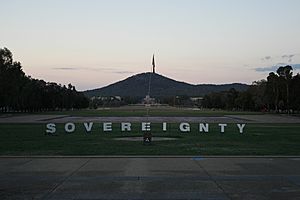Australian Aboriginal sovereignty facts for kids

Australian Aboriginal sovereignty is an idea and a movement. It started in the 20th century and continues today. It's about recognizing that Aboriginal and Torres Strait Islander peoples owned and controlled parts of Australia. They want this ownership to be officially recognized.
Currently, Australian law does not recognize Aboriginal sovereignty. Many people are calling for changes to the Australian Constitution. They want it to recognize that First Nations peoples were here first. They also want an Indigenous voice to parliament. Supporters believe recognizing prior ownership means accepting First Peoples' sovereignty. This could also lead to a treaty between First Peoples and the Australian Government.
Contents
Understanding Aboriginal Sovereignty
Australia's Ancient History
Aboriginal peoples have lived in mainland Australia for at least 65,000 years. This is a very long time. The British arrived and began settling in 1788. Governor Arthur Phillip and the First Fleet came then.
No Treaty Was Signed
When the British arrived, no treaty was signed with the Aboriginal peoples. A treaty is a formal agreement. This means Aboriginal people never officially gave up their land. Their sovereignty, or right to rule their land, was never given away.
Early Recognition Efforts
In 1836, a document for South Australia was different. It recognized the rights of the Aboriginal peoples of South Australia. However, after colonization, British law mostly ignored Aboriginal customs. By 1840, British law was made to replace all Aboriginal laws.
Why a Treaty Matters
A treaty between the Australian government and First Peoples could be very important. It would show respect for their long history on the land. It would also be a symbolic recognition of Indigenous sovereignty. Some treaty discussions have already started in different parts of Australia.
Protests for Recognition
The Aboriginal Tent Embassy
In 1972, the Aboriginal Tent Embassy was set up. It was placed on the steps of Old Parliament House, Canberra in Canberra. This was a protest to demand sovereignty for Aboriginal Australian peoples.
The Tent Embassy asked for several things. These included land rights and mineral rights to Aboriginal lands. They also wanted legal and political control of the Northern Territory. And they asked for payment for land that was taken.
Calls for a Treaty in 1988
In 1979, writer and activist Kevin Gilbert led a protest. It was called the "National Aboriginal Government." He called for Aboriginal sovereignty to be accepted.
In 1988, Australia celebrated its 200th anniversary. During this time, the "Aboriginal Sovereign Treaty '88 Campaign" began. It called for Aboriginal sovereignty to be recognized. It also wanted a treaty between Australia and Aboriginal nations. Kevin Gilbert was a leader of this campaign. He wrote a book in 1987 explaining the legal reasons for a treaty.
Modern Debates and Actions
The Tent Embassy Today
The Aboriginal Tent Embassy is still active today. It reached its 50th anniversary in 2022. It remains a powerful symbol of Aboriginal protest. People protest there about many Indigenous issues.
For example, protests have happened there about Aboriginal deaths in custody. They also protested against the 2007 Northern Territory Intervention. Cuts to services have also been protested. Today, the main issues are Aboriginal sovereignty and the right to self-determination. In 2012, there were seven tent embassies across Australia.
Calls for Constitutional Change
In 2012, a lawyer named Mick Dodson spoke to Parliament. He talked about "Constitutional Recognition of Indigenous Australians." He raised three important points:
- The Constitution should say that Aboriginal and Torres Strait Islander peoples were in Australia first. It should also say they owned the country when the British Crown claimed it. This means the land was taken without their permission.
- Aboriginal identity should be respected and protected in the Constitution and Australian law.
- Aboriginal people should have equal citizenship under the law.
Related Issues
Treaties and Constitutional Recognition
A treaty is a legal document. It defines the relationship between two groups that have their own authority. As of 2020, there are no treaties between the Australian Government and Indigenous peoples. However, talks are happening in some states and territories of Australia. They are discussing possible treaties between Indigenous peoples and governments.
There are also efforts to change the Australian Constitution. These changes would recognize prior occupation and ownership. This would acknowledge sovereignty. They also aim to put an Indigenous voice to parliament into the Constitution.
Symbolic Recognition of Land
Many public events in Australia now start with a "Welcome to Country" or "Acknowledgement of Country." This is a way to show respect for the traditional owners of the land. It highlights the cultural importance of the area to a specific Aboriginal group.
These welcomes are often given by elders from the local Aboriginal nation. Since 2008, a Welcome to Country has been part of the opening of the Parliament of Australia. This happens after every federal election.
See also
 In Spanish: Soberanía aborigen australiana para niños
In Spanish: Soberanía aborigen australiana para niños

